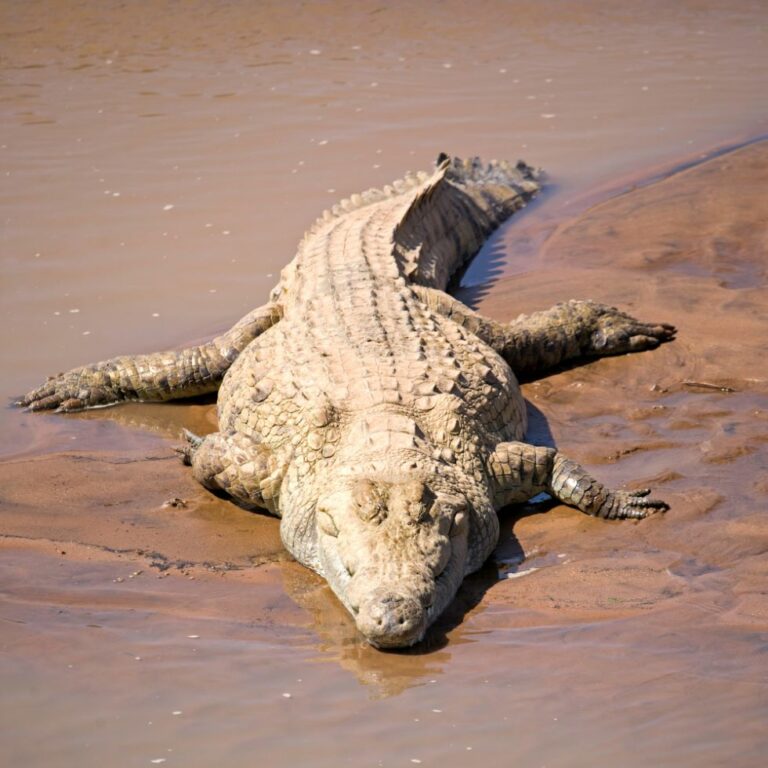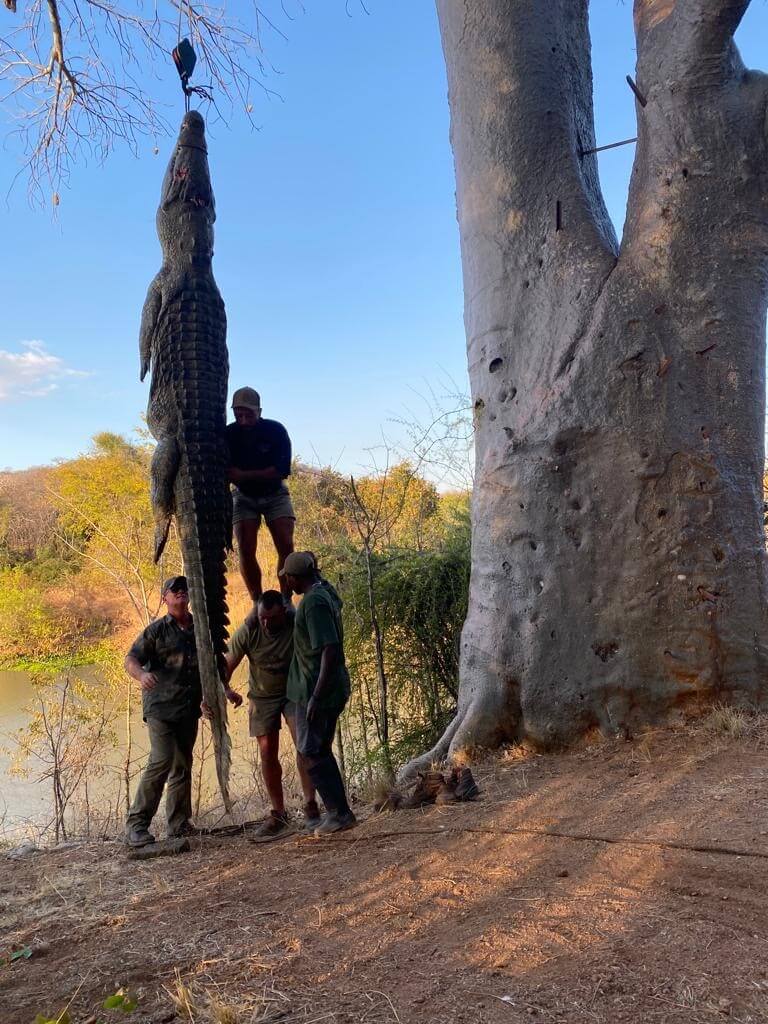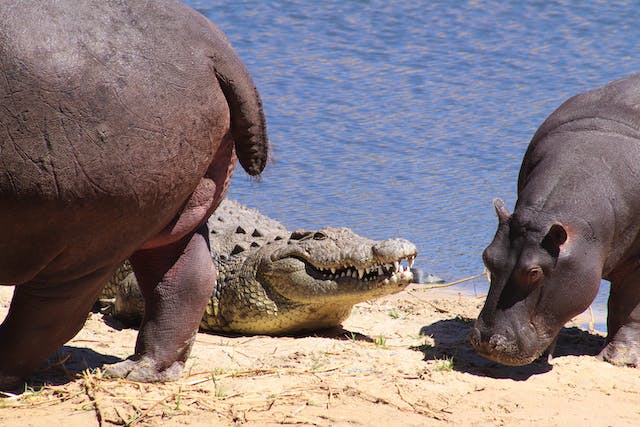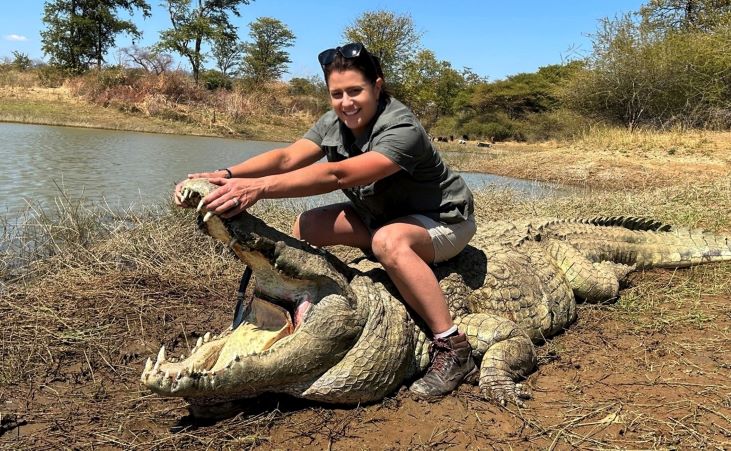Crocodile hunting in Africa is not for sissies. It is as simply put as that. No airs, no graces, no excuses. Hunting this deadly predator takes the patience of a saint, nerves of steel, tremendous courage, and exceptional shot placement to harvest a quality crocodile trophy.
Crocodile hunts are challenging, to say the least, but the rewards of hunting this prehistoric predator are exceptional.
[DYNAMIC-BLOGTABLEOFCONTENT]
The African Crocodile: A Worthy Adversary
Crocodile hunting in Africa is somewhat of a bucket list item for many aspiring dangerous game hunting enthusiasts. These bloody-thirsty apex predators are sought-after game hunting trophies, showcasing a hunter’s skill, perseverance, and courage in facing one of the world’s most dangerous game hunting trophies.
Africa is home to a variety of crocodiles that lay in wait for their next victims, ready to rip their flesh bone from bone. They lie in wait, often submerged in water with just their nostrils and eyes visible, watching and waiting for an opportune moment to strike.
For hunters wishing to enjoy a crocodile hunting adventure, the same principles apply: Slowly lying in wait, watching and waiting for the opportune moment to strike, the correct shot to be offered, and an enormously large (both literally and figuratively!) reward to emerge.

The Crocodile
From the tip of its dirty mouth sporting over 60 razor-sharp teeth to the end of its streamlined tail, the crocodile is a lean, mean, killing machine. They have thrived and survived for millions of years while many other species have become extinct. One cannot help but grudgingly admire one of Africa’s greatest apex predators.
Africa is home to four African Crocodile Sub-Species:
The West African slender-snouted crocodile (Mecistops cataphractus)
The West African slender-snouted crocodile is found in West and Central Africa. With an IUCN status of critically endangered, this medium-sized crocodile cannot legally be hunted in Africa. Their major reduction in numbers has been linked to many challenges, including poaching, as well as loss of habitat and therefore food resourced within that habitat.
The Dwarf Crocodile (Osteolaemus tetraspis)
As the world’s smallest crocodile, the dwarf crocodile is found in the sub-Saharan regions of West and Central Africa. The IUCN has listed its status as vulnerable, but it is still available for African hunting safaris in several areas.
The West African Crocodile (Crocodylus suchus)
This crocodile is listed by the IUCN as being “vulnerable” as its numbers have been diminishing, due to various reasons, including loss of habitat, poaching, and lack of food resources. It is available for game hunting safaris in various West and Central African countries.
The Nile Crocodile (Crocodylus niloticus)
The Nile crocodile prefers freshwater habitats, including swamps, lakes, rivers, and deltas. They are a common species in more than 26 African countries, making it a targeted dangerous game hunting species for many would-be African hunters in search of a challenging African hunt. With its widespread reach and abundance in numbers, the IUCN has listed its status as that of least concern.
Reaching up to 2,200 pounds, with an average length of 11-16 feet (although many areas have larger specimens), this cold-blooded killer has no conscience whatsoever. Renowned for their powerful bite strength, along with their famous death roll, it is almost impossible to escape from the grip of an adult Nile crocodile. Their technique of holding and rolling an animal underwater until it suffocates and dies is part of their hunting technique that makes them such adept predators.
The Nile crocodile is the crocodile species that is most targeted in dangerous game hunting in Africa, providing opportunities for hunters seeking adrenaline-filled, challenging hunting adventures.
This apex predator is renowned for its stealth, aggression, powerful jaws, and cunning nature, making it a worthy adversary for experienced game hunting enthusiasts. They have the strongest bite force in the animal kingdom, reaching up to 5,000 psi.

Taxidermy & Trophies Following a Crocodile Hunt
The exhilarating crocodile hunting adventure is now completed, and you have landed yourself an exceptional trophy! But what now? Have you considered how you plan to immortalize this magnificent beast? Luckily, there are various options available to you.
But before we move on to the trophy itself, you may wonder what happens to the meat after a crocodile hunt. You will be pleased to know, that upon harvesting your trophy crocodile, the meat gets donated to the local African communities in the area. There are very many exceptionally impoverished communities, and these donations are a great initiative to give back to the local people and provide them with food, and an excellent source of protein.
If you have not as yet tasted crocodile meat, ask your chef on the hunting safari to whip up a scrumptious meal of grilled crocodile steaks, or perhaps even a curry. The result will be well worth tasting!

Taxidermy
What is taxidermy?
Taxidermy, in a nutshell, involves preserving an animal’s body. This can be done in a couple of ways, including mounting and stuffing.
The animals are often portrayed in lifelike stances. Taxidermy has grown across the ages and is extremely popular with game hunting enthusiasts wishing to preserve a memento from a thrilling hunting safari.
Types of Crocodile Trophy Mounts
Displaying an exceptional trophy from a crocodile hunt in Africa is a great reminder of a wonderful African hunting trip, with many conversations and opportunities created to relive that exciting dangerous game hunting experience with your crocodile trophy taking center stage!
There are various styles and options available when it comes to styling your crocodile mount. Let’s look at some of the more popular options:
European Mount
This is also known as a skull mount and focuses on the crocodile’s skull.
Head Mount
This way of showcasing your crocodile hunting adventure allows the trophy to be smaller yet gives a great overview of the size of the crocodile, based solely on its head.
Full-Body Mount
When it comes to crocodile hunting trophies, sometimes only the biggest and the best (and most expensive!) are good enough. Should the budget allow, a full-body mount of your apex predator would be most impressive.
The crocodile’s entire skin gets used, with the trophy often dramatically posed with an African plains game prey in this predator’s natural habitat.
Pedestal Mount
This type of mounting style works well for the crocodile and often features it mounted in a leaping action. This style can be a reasonable alternative to the full body mount, as one still gets the impression of the size of the animal and the grandeur, with the same type of free-standing appeal, but at a lower cost.
Rug Mount
While it may be nice to have a pedestal or full-body mounted trophy to remind you of your crocodile hunt, you may want to consider a style that will display the trophy, without utilizing extra space or needing to make major changes to your trophy room or home. In this case, a rug mount may be just up your street!
A rug mount features the crocodile’s skin, enabling you to use the hide to maximum effect, showcasing your game hunting trophy with minimum fuss. This type of mount does not include the head.
Head–On Rug Mount
A head-on rug mount includes the crocodile’s head. To say that this is rather an impressive style to showcase your crocodile is an understatement! It certainly brings the wilderness to life and allows Africa into your home with this striking mounting style.
Crocodile Skin Items & Trinkets
Mounting options might not be what interests you in terms of crocodile mementos and keepsakes. Perhaps you are more interested in something a bit more tangible, that is going to be used more often. There are a great many options to consider when using the hide from your crocodile hunt, with some great options including:
Leather Items
Crocodile boots
Those boots were made for walking! Imagine the joy of being able to walk (or hunt!) in a pair of crocodile boots made from a crocodile that YOU harvested!
Rifle Bag
Every hunter needs a good quality rifle bag…imagine being in the position of having your rifle bag made from good quality leather, that you yourself harvested! What a pleasure! So that each time you hunt, you have great memories of an exciting dangerous game hunting adventure in Africa!
A briefcase or Document Bag
The challenging thing about hunting is that you need money to hunt and it can become expensive. So what better way to remind yourself why you have a 9-5 job than using your NEW crocodile leather document bag daily?
Other Leather Goods
From belts, wallets, and bags to ammo holders, sunglasses pouches, and jewelry, the crocodile’s hide can be used for many beautiful items. These items are both useful and be in daily use, a subtle reminder of your adrenaline-filled dangerous game hunting adventure!
Jewellery
From crocodile scale earrings to tooth necklaces and bracelets, you can expect some beautiful and unusual pieces to be created from crocodile leather.
Trinkets
Items such as key rings, cosmetic bags, knife handles, and ornaments are sculpted from the animal’s teeth and bones.
Sound intriguing? Find out more about crocodile accessories and see whether your crocodile’s size would warrant some of these options.
Frequently Asked Questions
Is it dangerous to hunt crocodiles?
Yes, crocodiles are extremely dangerous reptiles that are always in search of their next meal. The most aggressive of all African crocodiles is the Nile crocodile which is also responsible for hundreds of human deaths each year.
Where in Africa can you hunt crocodiles?
Crocodile hunting safaris are available throughout many African countries, with the aggressive Nile crocodile found in more than 26 countries across the African continent. Some of the most popular destinations for hunting crocodiles include Zambia, Zimbabwe, and Mozambique.
Lake Cahora Bassa in Mozambique is renowned for its monster crocodile trophies, while Lake Kariba in Zambia and Zimbabwe also harvest some large quality crocodile trophies. A crocodile hunt to any of these destinations will not disappoint!

Is Crocodile Hunting Rewarding?
Yes, crocodile hunting is both extremely challenging and rewarding. The bloody-thirsty predators are a thrill to target and hunt, testing a hunter’s skills to the limit. The reward of being able to say that you have hunted one of Africa’s apex predators is priceless! And, if you are so inclined to, another reward is the exceptionally beautiful trophy to add to your home collection!
Are Crocodiles Members of the Dangerous 7?
Yes, together with the Big 5 and the hippo, the Nile crocodile is a member of the Dangerous 7. These seven species are seen as the seven most dangerous animals to hunt and target on foot.
When referring to dangerous game hunting, many hunters start with members of the Big 5 (lion, leopard, elephant, rhino, and Cape buffalo) and then move on to the Dangerous 7. The Dangerous 7 consists of the Big 5, plus the hippo and crocodile.
Which of the Crocodile Species is most aggressive?
Standing out head and shoulders above the rest in terms of aggression would be the Nile crocodile. This apex predator, with its 60-plus razor-sharp teeth, webbed feet, and strong tail, is a force with which to be reckoned and is a perfectly designed killing machine, just waiting for its next victim. It has not survived this long without good reason!
What Caliber Rifle should I use on a Crocodile hunt?
When hunting crocodiles, a high-powered, accurate rifle is highly recommended to ensure a quick and ethically dangerous game hunting safari. A minimum requirement of a .375 is required for dangerous game hunting in Africa Shots will be at the brain, through a thick skull, or the vertebrae.
What hunting methods are used to target a Nile crocodile?
Nile crocodiles are often hunted from a blind. Alternatively, hunters set out on a mokoro (traditional canoe) from where they spot a suitable crocodile. A short walk-and-stalk follows, after which the animal is targeted.
What shot placement is best on the Nile crocodile?
The best shot placement on a crocodile hunt is, like with all shot placement everywhere, dependent on the angle. Learn more about crocodile shot placement and how best to target this cold-blooded killing machine. The one piece of advice that is universal, no matter what angle you are shooting from, is to ensure that you are 100% committed to the shot and that it is on target. If in doubt, leave the shot and wait for another opportunity.
What animal would be a good option to hunt with a Crocodile?
A hippo would be an excellent choice if you are looking to target another animal. Since these species share the same habitat, you would already be in the right location, with the correct caliber rifle to target another dangerous game species.

Pick Your Trophy
While crocodile hunting in Africa remains a sought-after and memorable hunting experience, the trophy is even more exceptional. If you’ve booked a crocodile hunting safari, give some thought as to how you plan to commemorate your unique hunting trophy, whether it be a fully-mounted croc to add to your trophy room, or a new pair of crocodile leather boots. Whichever choice you make, this African hunting trophy will surely not be forgotten.
Author: B. Hershensohnn
